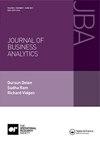AGGFORCLUS: A hybrid methodology integrating forecasting with clustering to assess mitigation plans and contagion risk in pandemic outbreaks: the COVID-19 Case Study
IF 1.6
Q3 COMPUTER SCIENCE, INFORMATION SYSTEMS
引用次数: 1
Abstract
ABSTRACT The COVID-19 pandemic showed governments’ unpreparedness as decision-makers hastily created restrictions and policies to contain its spread. Identifying prospective areas with a higher contagion risk can reduce mitigation planning uncertainty. This research proposes a risk assessment metric called AGGFORCLUS that integrates time-series forecasting and clustering to convey joint information on predicted caseload growth and variability, thereby providing an educated yet visually simple view of the risk status. In AGGFORCLUS, the development is sectioned into three phases. Phase I forecasts confirmed cases using a mixture of five different forecasting methods. Phase II develops the identified best model forecasts for an extended ten-day horizon, including their prediction intervals. In Phase III, we calculate average growth metrics for predictions and use them to cluster series by their multidimensional average growth. We present the results for various countries framed into a nine-quadrant risk-grouped associated measure linked to the expected cumulative caseload progress and uncertainty.AGGFORCLUS:将预测与聚类相结合的混合方法,用于评估大流行疫情中的缓解计划和传染风险:COVID-19案例研究
COVID-19大流行表明政府准备不足,决策者匆忙制定限制和政策来遏制其传播。确定传染风险较高的潜在地区可以减少减灾规划的不确定性。本研究提出了一种称为AGGFORCLUS的风险评估指标,该指标集成了时间序列预测和聚类,以传达有关预测病例量增长和变异性的联合信息,从而提供了一种有知识但视觉上简单的风险状态视图。在AGGFORCLUS中,开发分为三个阶段。第一阶段混合使用五种不同的预测方法预测确诊病例。第二阶段为延长的10天范围开发确定的最佳模型预测,包括其预测间隔。在第三阶段,我们计算了预测的平均增长指标,并利用它们对多维平均增长序列进行聚类。我们将各国的结果纳入与预期累积病例量进展和不确定性相关的九象限风险分组相关测量。
本文章由计算机程序翻译,如有差异,请以英文原文为准。
求助全文
约1分钟内获得全文
求助全文
来源期刊

Journal of Business Analytics
Business, Management and Accounting-Management Information Systems
CiteScore
2.50
自引率
0.00%
发文量
13
 求助内容:
求助内容: 应助结果提醒方式:
应助结果提醒方式:


